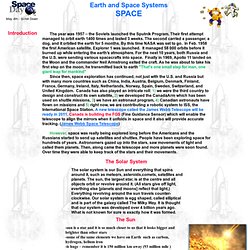

The Moon - Zoom Astronomy. The moon is Earth's only natural satellite.

The moon is a cold, dry orb whose surface is studded with craters and strewn with rocks and dust (called regolith). The moon has no atmosphere. Recent lunar missions indicate that there might be some frozen ice at the poles. The same side of the moon always faces the Earth. The far side of the moon was first observed by humans in 1959 when the unmanned Soviet Luna 3 mission orbited the moon and photographed it. Ten Cool Sites: Fun & Educational Websites. Astronomy Crossword (Crossword Puzzle) Science Classroom. Lessons Adopt-A-Constellation (Student worksheet provided) Great Gravity (Student worksheet provided) Moon Phases Activity (Student worksheet provided) NOTE: Visit the Earth Science section of the Middle School Science site for great astronomy ideas!

Internet Lessons • Astronomy Scavenger Hunt (pdf) - A series of "Who am I? " questions to explore the history of astronomy. Contributed by Stacy Baker • Past and Present Scavenger Hunt (pdf) - Explore Roman and Greek myths and their relationship to astronomy with this worksheet from Stacy Baker. . • Surprise on Mars (pdf) - Worksheet created by Stacy Baker to explore Mars! Also available ... • Astro Bingo (pdf) - Students use astronomy terms to fill in their bingo cards. . • Astronomy Word Search (pdf) • Constellation Word Search (pdf) • What's Your Sign? Note For Teachers: Please take time to preview the links on any Internet assignment before you use it with your students. Also available ... Need Adobe Acrobat to view the worksheets on this site? Solar System, Solar System Information.
Our Cosmic Neighborhood From our small world we have gazed upon the cosmic ocean for thousands of years.

Ancient astronomers observed points of light that appeared to move among the stars. They called these objects "planets," meaning wanderers, and named them after Roman deities—Jupiter, king of the gods; Mars, the god of war; Mercury, messenger of the gods; Venus, the goddes of love and beauty, and Saturn, father of Jupiter and god of agriculture. The stargazers also observed comets with sparkling tails, and meteors or shooting stars apparently falling from the sky. Since the invention of the telescope, three more planets have been discovered in our solar system: Uranus (1781), Neptune (1846), and, now downgraded to a dwarf planet, Pluto (1930). The four planets closest to the sun—Mercury, Venus, Earth, and Mars—are called the terrestrial planets because they have solid rocky surfaces. Nearly every planet—and some of the moons—has an atmosphere. BBC Space – Explore the planets, black holes, stars and more.
Science6space1. Earth and Space Systems The year was 1957 – the Soviets launched the Sputnik Program.

Their first attempt managed to orbit earth 1400 times and lasted 3 weeks. The second carried a passenger, a dog, and it orbited the earth for 5 months. By this time NASA was set to go. In Feb. 1958 the first American satellite, Explorer 1 was launched. Since then, space exploration has continued, not just with the U.S. and Russia but with many more countries such as China, India, Austria, Belgium, Denmark, Finland, France, Germany, Ireland, Italy, Netherlands, Norway, Spain, Sweden, Switzerland, and United Kingdom. However, space was really being explored long before the Americans and the Russians started to send up satellites and shuttles. The solar system is our Sun and everything that spins around it, such as meteors, asteroids,comets, satellites and planets. -sun is a star and it is so much closer to us that it looks bigger and brighter than other stars -we feel the heat from it -made up of gases.
Grade 6 Astronomy Unit. Grade 6 Astronomy Unit The Pan-Canadian Science Curriculum recommends objectives for all science units in each grade as a way of unifying the science courses taught from province to province.

Most provinces have adopted the objectives into their own curricula, and have designed courses around them. Though grade 6 courses still vary slightly across the country, presented below is a complete unit plan which covers all of the objectives in the Pan-Canadian Protocol. This unit can be used as-is to cover many (if not all) of your provincial expectations, or modified as you see fit. The reference numbers given for each lesson below refers to the Pan-Canadian specific learning outcomes. A complete listing of the Pan-Canadian Curriculum Objectives for grade 6 Earth and Space Science can be found here, while provincial curriculum objectives listed by province and grade can be found here.
CSA grade 6 resources. Finally, need an idea for a summative assessment activity? Check here! Lesson 1: Lesson 2: Tides. Physics 20b: Introduction to Cosmology - Spring 2010 - Download free content from UC Irvine.